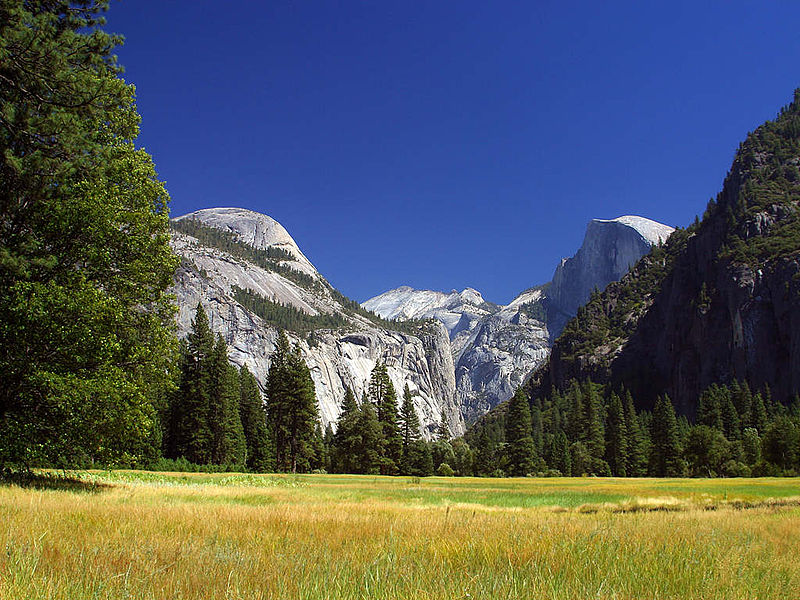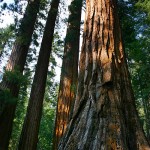
I suspect I am following the news of fires affecting the Yosemite National Park a little more closely than most. That’s partly because I was there around two and a half months ago and also because there is an interesting conservation back-story to present day events.
Yosemite, in the California Sierra Nevada mountains, was the USA’s third National Park (Sequoia ‘beat’ it to second by a matter of days in 1890).
![El Capitan. By Reinhard Jahn, Mannheim * nanosmile (selbst fotografiert, nanosmile) [CC-BY-SA-2.0-de (http://creativecommons.org/licenses/by-sa/2.0/de/deed.en)], via Wikimedia Commons](https://markavery.info/wp-content/uploads/2013/08/390px-ElCapitan-001-150x150.jpg)
However, the fire that is still nowhere near under control is threatening another of Yosemite’s valleys, one that is, or rather was, said to be the equal of Yosemite itself – the Hetch Hetchy Valley.
Hetch Hetchy was drowned in order to make a reservoir to supply San Francisco with water after the 1906 San Francisco earthquake where one of the problems was the lack of water to put out fires. Hetch Hetchy supplies San Francisco with water, gravity fed, to this day, and is the reservoir threatened by the fire that is often mentioned in the news bulletins.
John Muir, the Scot who helped give the USA the idea of National Parks, and who promoted Yosemite as a National Park, was dead against Hetch Hetchy being flooded but he lost the political argument.
 I’m a bit worried about the small grove of giant sequoia that I visited. They don’t seem too far from the flames to me and I wonder what happens if the flames reach them. They must have got through fires before, as they are very old and fire is a natural part of the ecosystem but I just wonder…
I’m a bit worried about the small grove of giant sequoia that I visited. They don’t seem too far from the flames to me and I wonder what happens if the flames reach them. They must have got through fires before, as they are very old and fire is a natural part of the ecosystem but I just wonder…
![Inklein at en.wikipedia [GFDL (www.gnu.org/copyleft/fdl.html) or CC-BY-SA-3.0 (http://creativecommons.org/licenses/by-sa/3.0/)], from Wikimedia Commons](https://markavery.info/wp-content/uploads/2013/08/800px-OShaughnessy_Dam.jpg)
Terrible news indeed about the fire at Yosemite. Ironically, when oil was first discovered underground (it came from whales before that), petroleum was considered far too volatile to be of use, so a party trick they did with this “useless by-product”, was to pour it down Yosemite falls and set fire to it to enthral an appreciative audience below. As if the falls weren’t beautiful enough without that. And how wrong they were about petrol.
Tim – wow! I didn’t know that!
“I suspect….”.
On the week the unscientific badger cull begins here in Blighty, you suspect right as far as I’m concerned.
There’s little room for yosemite in my thoughts right now.
Mark – I’ve read in Oliver Rackham’s Woodlands that in some parts of the world, notably Australia, these fire regimes have been disrupted by the presence of alien invasive plants or the absence of one or more species of native trees subtracted by disease – e.g. alter the natural mix of species and the fires burn hotter and longer and so kill more of the mature trees, meaning the natural cycle of renewal following a fire doesn’t work as effectively. So, like you, I hope the giant sequoia you saw are ok. Worrying times.
I have many memories resulting to camping in this massive park and even more terrifying memories of how quickly these fire start and spread, I recall the wildfire that was started on a big grassland meadow at the back of our house by a lighting strike, but they happen all the time.
It’s interesting you mention the great fire of 1906 (April 18th) as it was always taught at school and even a visit to a museum dedicated to the tragedy, did you know the fire was only halted because the fire reached buildings who’s frames were built from the timber of sequoia trees, the lack of resin meant it was quite fire resistance?
Also fire helps the giant sequioa by destroying the plant/tree life around fallen seeds (the fire also helps open up these seeds) thus helping germinate the sequoia. I would be surprised if many if any are damaged by this fire…..
Douglas – many thanks – very interesting.
Don’t worry about the giant sequoias; they should be fine and indeed will possibly benefit from the fire.
http://news.nationalgeographic.com/news/2013/08/130826-giant-sequoias-yosemite-rim-fire-forestry-science/
Nick – thank you! That’s one fewer worry then! Just hen harriers, farmers, badgers, turtle doves, bluefin tuna, skylarks, arable plants, small tortoiseshells …….left to worry about now. What a relief!
Mark, here,s another worry for you. There is a rumour that the Government are reducing staff at Natural England so that it is easier for another organisation (RSPB) to take over our NNRs without the problem of Pensions for staff. This was the one thing that stood in the way of a “give away NNRs” last time. If this happens, will the RSPB charge us for visiting our own nature reserves?
Like DMD I’m afraid I too am thinking like a ‘nimby’ and wondering what to do about the badger culls in Somerset. That’s not to say I am belittling the Yosemite fires.
Back to who to ‘badger’ – do I write to the Govt. or NFU et. al. and indicate that as a consequence of their decision I will not be purchasing British meat until they cease the culls and review their position. Perhaps its time I became a vegetarian so I don’t buy foreign inports either. Now milk, that’s a bit more difficult dilemma to resolve perhaps, but I’m working on it. There is also the impact upon Somerset tourism, agricultural diversification generates income from bed and breakfast revenue, guess I can’t visit Exmoor now either.
So, how long before they do the scientific analysis, who is the independent (ha) adjudicator on the debacle?
The State of Nature: rapid decline still and Natural England (shotgun to their heads) sign off more destruction for agri-industry.
If NNRs are given away, then they may well come with serious access liabilities if Natural England get their way with Open Access. See http://you.38degrees.org.uk/petitions/stop-rethink-national-nature-reserves-as-open-access
NNRs were purchased with public funds, surely they cannot be disposed of without open, transparent public consultation, can they? Ha, I recall various comments about public apathy, so ok, watch this space?
Remember also, that there are Public Rights of Way already in existence on some sites, similarly Rights of Common, so these could not be extinguished to generate gate revenue, but then again who knows these days with public apathy?
There are far too many SSSIs and Natura 2000 sites failing to achieve favourable status for their interest features, the State of Nature attests to continuing decline in species and habitats, so if NNRs become country parks for horses, dogs, bikes then who knows what ‘Higher Access’ will bring, quad bikes, 4x4s, trains across them? All you need here in parts of Yorkshire is a Water Level management Plan and you uplift condition status a notch, probably two or three if you then implement it? But will that stem the haemorrhaging biodiversity, will SoN2 tell us in due course I wonder?
Open Access, could potentially bring with it a conflict between demands for quality access provision and associated infrastructure (car parks, cafes with facilities etc. playgrounds for the kids, dirt tracks for the bikes etc.) on sensitive sites and then what about the special interest features such as nightjar, woodlark and any other ground nesting birds? Managed access, mmmh, yes I’ve witnessed the actions not taken when visitors have killed adders because they might bite their unleashed pets, the failure to act when visitors have been bitten by unleashed dogs, the owners who think it ok to leave piles of pooh and not give wheelchairs or their owners a second thought. I love my dogs but I love nature too and I respect its right to priority in some special places.
We would add that we’re not oppossed to Open Access, but there must be adherence to the Habitats Directive, open and transparent public consultation, sufficient funds in place at the point of dedication to guarantee monitoring and management to ensure no Likely Significant Effect upon interest features.
Are Government Ministers confident that the Board of Natural England and their Senior Directors advocating no conflict of interest are assured of the position they promote?
Please help us raise the profile of the risk to the gems in the nations crown jewels and consider signing the petition, http://you.38degrees.org.uk/petitions/stop-rethink-national-nature-reserves-as-open-access
The State of Nature surely needs NNRs for NATURE reserves not their evolution to country parks or theme parks?
Interesting thoughts about NNRs – but back to Yosemite.
It was recognised long ago that a huge conservation management mistake had been made during the late 19th and most of the 20th century in American National Parks, which spent considerable resources preventing fires from spreading through ecosystems that were fire-adapted. This led to a build up of dry deadwood. Eventually a lightning strike, jettisoned cigarette butt or careless camper set alight to a bit of it, leading to a massive uncontrollable artificially intense fire. As I understand it over the past 25 years, National Parks in the West have been gradually trying to reduce their “excess” fuel load through controlled burning. See http://www.nps.gov/yose/parkmgmt/fire-history.htm
Whatever, there has been a huge build up of additional dry dead timber across the National Park forests of the States and the consequence is these massive uncontrollable fires. While the giant sequioia is fire-dependent (the fire removes the extraordinarily deep layer of “duff” which builds up under the trees) enabling the seeds to actually reach soil level, as well as receive a handy dose of potash, a really intense fire could kill individuals especially if they are already weakened by pollution, compaction, root damage etc.
It does raise an interesting question in my mind about re-wilding. One could argue that removing the 4000 years (or more) of deliberate fire-setting that occurred in Yosemite until the National Park was established, was in keeping with re-wilding, by removing a major human impact. Large uncontrollable wildfires are a consequence of that approach – though presumably after a long enough time period, the “natural” fire cycle will be reinstated. In which case the damage done to the ecosystem during this period of adjustment will need to be weighed up against the benefit of re-wilding.
Miles – many thanks, that’s very interesting.